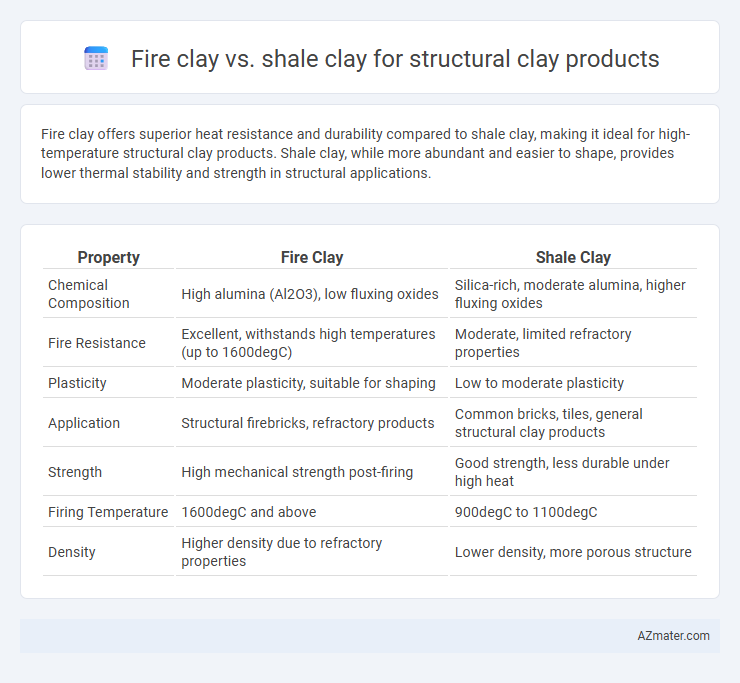Fire clay offers superior heat resistance and durability compared to shale clay, making it ideal for high-temperature structural clay products. Shale clay, while more abundant and easier to shape, provides lower thermal stability and strength in structural applications.
Table of Comparison
| Property | Fire Clay | Shale Clay |
|---|---|---|
| Chemical Composition | High alumina (Al2O3), low fluxing oxides | Silica-rich, moderate alumina, higher fluxing oxides |
| Fire Resistance | Excellent, withstands high temperatures (up to 1600degC) | Moderate, limited refractory properties |
| Plasticity | Moderate plasticity, suitable for shaping | Low to moderate plasticity |
| Application | Structural firebricks, refractory products | Common bricks, tiles, general structural clay products |
| Strength | High mechanical strength post-firing | Good strength, less durable under high heat |
| Firing Temperature | 1600degC and above | 900degC to 1100degC |
| Density | Higher density due to refractory properties | Lower density, more porous structure |
Introduction to Structural Clay Products
Structural clay products are primarily made from naturally occurring clays, with fire clay and shale clay being two common types used in manufacturing. Fire clay, known for its high alumina content and refractory properties, offers excellent resistance to high temperatures and thermal shock, making it ideal for kiln bricks and firebrick applications. Shale clay, composed mainly of fine-grained sedimentary rock fragments, provides uniform texture and plasticity, enhancing the strength and durability of structural clay products like bricks and tiles used in building construction.
Overview of Fire Clay
Fire clay is a highly refractory material composed mainly of kaolinite and quartz, renowned for its exceptional heat resistance in structural clay products such as bricks and tiles. It withstands temperatures above 1,400degC, making it ideal for applications in furnaces, kilns, and fireplaces where thermal durability is critical. Compared to shale clay, fire clay offers superior refractoriness and lower impurity content, enhancing the strength and longevity of high-temperature clay products.
Overview of Shale Clay
Shale clay, a fine-grained sedimentary rock composed primarily of clay minerals and silt-sized particles, plays a crucial role in manufacturing structural clay products like bricks and tiles. Its uniform particle size and plasticity provide excellent moldability and strength after firing, often resulting in durable and weather-resistant materials. Unlike fire clay, shale clay typically has lower refractory properties but offers better workability and consistency for mass production of construction components.
Chemical Composition Comparison
Fire clay exhibits a higher alumina content, typically ranging from 25% to 40%, which enhances its refractory properties and thermal stability in structural clay products. Shale clay, in contrast, contains a greater proportion of silica, often between 45% and 60%, contributing to its strength and durability but with lower heat resistance. The chemical composition of fire clay with elevated alumina (Al2O3) and lower silica (SiO2) differentiates it from shale clay, which has higher silica and more iron oxide (Fe2O3), influencing the fired color and mechanical properties of the final clay product.
Physical Properties: Strength and Durability
Fire clay exhibits superior strength and high thermal resistance, making it ideal for structural clay products subjected to extreme heat and mechanical stress. Shale clay, while durable, generally offers lower compressive strength and less thermal stability compared to fire clay, affecting its suitability for heavy-duty applications. The dense structure and high alumina content of fire clay contribute to its enhanced durability and resistance to wear, outperforming shale clay in long-term structural integrity.
Firing Temperatures and Behavior
Fire clay typically requires higher firing temperatures ranging from 1200degC to 1400degC to achieve optimal vitrification and mechanical strength in structural clay products. Shale clay, on the other hand, matures at slightly lower temperatures between 900degC and 1150degC, producing denser bodies with less shrinkage due to its finer particle size and mineral composition. Fire clay exhibits better refractory properties and resistance to thermal shock, making it suitable for high-temperature applications, whereas shale clay is favored for uniform firing and ease of shaping in bricks and tiles.
Workability and Processing Differences
Fire clay exhibits higher plasticity and better workability compared to shale clay, making it easier to mold and shape in structural clay product manufacturing. The processing of fire clay involves higher firing temperatures, resulting in stronger and more durable products due to its refractory properties. Shale clay, with lower plasticity, requires more additives for workability and is typically fired at lower temperatures, producing less dense but lighter structural elements.
Application Suitability in Construction
Fire clay exhibits exceptional heat resistance and durability, making it ideal for high-temperature structural clay products such as firebricks used in furnaces, kilns, and fireplaces. Shale clay, characterized by its fine particle size and plasticity, suits the production of lightweight structural clay components like bricks and tiles for general building applications where thermal resistance is less critical. Selecting fire clay over shale clay enhances the longevity and performance of structural elements exposed to extreme heat and thermal cycling in construction environments.
Cost Efficiency and Availability
Fire clay, known for its high refractory properties, generally costs more than shale clay but offers superior durability for structural clay products used in high-temperature environments. Shale clay is more widely available and less expensive, making it a cost-efficient choice for general structural applications where extreme heat resistance is not required. The balance between fire clay's enhanced performance and shale clay's affordability and availability drives material selection based on specific project needs and budget constraints.
Environmental Impact and Sustainability
Fire clay offers a higher resistance to heat and weathering, reducing the need for frequent replacement, which minimizes environmental waste in structural clay products manufacturing. Shale clay, being more abundant and easier to mine, presents lower extraction-related emissions but often requires higher energy consumption during firing due to its chemical composition, impacting overall sustainability. Lifecycle assessments highlight fire clay's durability benefits and shale clay's accessibility, guiding eco-conscious choices in structural clay material selection.

Infographic: Fire clay vs Shale clay for Structural clay product
 azmater.com
azmater.com